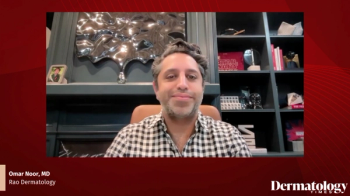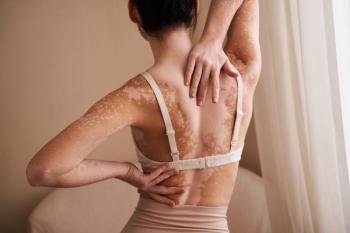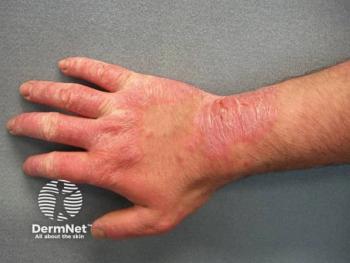
- Dermatology Times, June 2025 (Vol. 46. No. 06)
- Volume 46
- Issue 06
Oral Ritlecitinib Plus nbUV-B Accelerates Repigmentation in Nonsegmental Vitiligo

Key Takeaways
- Vitiligo's psychological impact underscores the need for new treatments, with current options offering variable results in restoring skin color.
- Promising therapies include FDA-approved topical ruxolitinib and oral JAK inhibitors like ritlecitinib, showing efficacy in clinical trials.
Discover promising advancements in vitiligo treatments, including innovative therapies and combination approaches that enhance skin repigmentation and improve patient quality of life.
Recent research in vitiligo has focused on gaining a better understanding of the autoimmune disease and developing treatments that best serve patients. Given its significant psychological impact, including depression, anxiety, impaired personal and social relationships, negative self-esteem, and impaired quality of life, vitiligo presents an imminent need for additional treatment options. Clinically, vitiligo is classified as segmental (ie, affects only 1 side of the body or a specific area, such as the hands or face) or as nonsegmental vitiligo (NSV; ie, depigmented macules appear symmetrically on various parts of the body, face, hands, and feet). NSV is the most common type of vitiligo.1-3
Current vitiligo treatments aim to restore skin color or even out skin tone, but results can vary. Common treatment approaches include topical, oral, or injectable corticosteroids, calcineurin inhibitors, and narrowband UV-B (nbUV-B) light therapy, but no systemic pharmacological treatments are currently approved for NSV.
New advancements in therapeutics to repigment skin include the introduction of FDA-approved topical ruxolitinib (Opzelura) 1.5% cream and oral Janus kinase (JAK) inhibitors such as ritlecitinib (Litfulo), upadacitinib (Rinvoq), and povorcitinib (formerly INCB54707), which have shown promising results in phase 2 studies. Research has confirmed the autoimmune nature of vitiligo and identified key molecular mechanisms involved in melanocyte destruction, paving the way for more targeted therapies. Povorcitinib and upadacitinib (JAK1 inhibitors) are being evaluated as monotherapy in phase 3 studies, and anifrolumab-fnia (Saphnelo), an anti–interferon-α antibody; afamelanotide (Scenesse), a synthetic hormone; and baricitinib (Olumiant), a JAK1/2 inhibitor, are being evaluated in combination with nbUV-B in phase 2 and phase 3 studies.
My team also conducted the pilot study to investigate apremilast (Otezla), a PDE4 inhibitor, in combination with nbUV-B.4,5 Advances in light therapy, including the ability to perform it at home, have made treatment more accessible and convenient. Skin grafting techniques also offer an option for some patients. There is a growing understanding of the psychological impact of vitiligo and the importance of providing supportive care, including cognitive behavioral therapy and support groups.
My team has participated in a phase 2b clinical trial (NCT03715829) of ritlecitinib, an oral JAK3/TEC family kinase inhibitor, in adult patients with active NSV. Ritlecitinib has high selectivity over the other 3 JAK isoforms (JAK1, JAK2, and TYK2) and over the broader human kinome. Ritlecitinib 50-mg daily dose received marketing approval for the treatment of severe alopecia areata in the United States and European Union in 2023 and is also approved in Japan, China, the United Kingdom, and Canada. Ritlecitinib is currently under investigation in phase 3 studies for NSV.
In the phase 2b vitiligo study, ritlecitinib 50 mg with or without a 100- or 200-mg loading dose once daily was efficacious, as measured by the Facial-Vitiligo Area Scoring Index and the Patient Global Impression of Change scale, and well tolerated over 48 weeks of treatment in adults with active NSV.6 At the molecular level, skin biopsy samples showed significant dose-dependent downregulation in T-cell activation, natural killer cell, cytotoxic, type 1 immune, and type 2 immune markers in response to ritlecitinib.7 In this study, ritlecitinib also demonstrated efficacy on stable and active vitiligo lesions by reducing type 1 and type 2 immunity.8 Ritlecitinib also showed a similar efficacy and safety profile across Fitzpatrick skin types I through VI.9
During the extension period of this study, patients had an opportunity to receive additional ritlecitinib treatment with or without nbUV-B phototherapy. Overall, the study showed that ritlecitinib is a promising novel treatment for NSV. Ritlecitinib alone was effective in improving repigmentation, but when combined with nbUV-B, the efficacy results were even more significant. Patients receiving the combination therapy experienced greater improvements in facial and total body repigmentation compared with those receiving ritlecitinib alone. Specifically, combination therapy led to a 69.6% mean improvement in facial repigmentation vs 55.1% with ritlecitinib monotherapy. Moreover, the combination therapy of ritlecitinib plus nbUV-B was well tolerated and offers a new approach to enhance outcomes for patients with vitiligo.10
The ritlecitinib phase 3 program includes 3 studies designed to evaluate the efficacy, safety, and tolerability of ritlecitinib at doses of 50 mg and 100 mg daily in adult and adolescent patients with NSV. These studies are Tranquillo (NCT05583526), Tranquillo LTE (NCT06163326), and Tranquillo 2 (NCT06072183). The main objectives of the program are to demonstrate statistically significant and meaningful repigmentation compared with placebo and a favorable benefit-risk profile.
In vitiligo, it can take up to 1 year of treatment to achieve meaningful repigmentation. Consequently, a 2-step approach is needed. The first therapy focuses on the reduction of inflammation and the cessation of melanocyte destruction, and the second therapy focuses on the induction of melanocyte growth and spreading. Therefore, combination therapy with nbUV-B is expected to expedite the response because the immunomodulators are thought to affect step 1 therapy and the phototherapy would contribute to the second step.
The increased interest in the combination therapy is also based on preliminary data showing that the novel immunomodulatory pharmaceuticals combined with nbUV-B phototherapy demonstrated enhanced repigmentation by leveraging the potential additive or even synergistic effects of both treatments. The combination therapy may provide rapid and clinically meaningful repigmentation, which could significantly improve patients’ quality of life.10
The ongoing clinical trials for vitiligo are sparking significant interest and optimism for better treatment outcomes. Key expectations include enhanced repigmentation, safety, and rapid efficacy. Additionally, there is a hope for additive or synergistic effects when combined with nbUV-B phototherapy, particularly in difficult-to-treat areas such as hands and feet.
Overall, these trials are expected to offer new insights into novel vitiligo treatments. The findings could pave the way for more efficacious and accessible therapies, offering hope to patients who have struggled with NSV. By exploring new treatment avenues, researchers aim to enhance the quality of life for individuals with vitiligo, making advanced care more widely available and potentially leading to more efficacious and accessible therapies for patients. Physicians can support patients with vitiligo by offering a combination of medical treatments, emotional support, and educational resources and by helping them understand that vitiligo is a chronic condition. Research is ongoing to develop therapies that can provide long-term repigmentation and prevent recurrence.
Emma Guttman-Yassky, MD, PhD, is the Waldman Professor of Dermatology and Immunology, health system chair of the Kimberly and Eric J. Waldman Department of Dermatology, and director of the Occupational Dermatitis Clinic and the Laboratory for Inflammatory Skin Diseases at Icahn School of Medicine at Mount Sinai in New York, New York.
References
- Czarnowicki T, He H, Leonard A, et al. Blood endotyping distinguishes the profile of vitiligo from that of other inflammatory and autoimmune skin diseases. J Allergy Clin Immunol. 2019;143(6):2095-2107. doi:10.1016/j.jaci.2018.11.031
- Choung RS, Ramakrishna J, Pradhan V, et al. Ritlecitinib, a JAK3 /TEC inhibitor, modulates the markers of celiac autoimmunity in alopecia areata and vitiligo patients. Arch Dermatol Res. 2025;317(1):280. doi:10.1007/s00403-024-03784-6
- Gay-Mimbrera J, Lozano-Ojalvo D, Gómez-Arias PJ, et al. Comprehensive single-cell chromatin and transcriptomic profiling of peripheral immune cells in non-segmental vitiligo. Br J Dermatol. Published online January 31, 2025. doi:10.1093/bjd/ljaf041
- Kim HJ, Singer GK, Del Duca E, et al. Combination of apremilast and narrowband ultraviolet B light in the treatment of generalized vitiligo in skin phototypes IV to VI: a randomized split-body pilot study. J Am Acad Dermatol. 2021;85(6):1657-1660. doi:10.1016/j.jaad.2020.12.073
- Kim HJ, Del Duca E, Pavel AB, et al. Apremilast and narrowband ultraviolet B combination therapy suppresses Th17 axis and promotes melanogenesis in vitiligo skin: a randomized, split-body, pilot study in skin types IV-VI. Arch Dermatol Res. 2023;315(2):215-221. doi:10.1007/s00403-022-02343-1
- Ezzedine K, Peeva E, Yamaguchi Y, et al. Efficacy and safety of oral ritlecitinib for the treatment of active nonsegmental vitiligo: a randomized phase 2b clinical trial. J Am Acad Dermatol. 2023;88(2):395-403. doi:10.1016/j.jaad.2022.11.005
- Guttman-Yassky E, Del Duca E, Da Rosa JC, et al. Improvements in immune/melanocyte biomarkers with JAK3/TEC family kinase inhibitor ritlecitinib in vitiligo. J Allergy Clin Immunol. 2024;153(1):161-172e8. doi:10.1016/j.jaci.2023.09.021
- Yamaguchi Y, Peeva E, Del Duca E, et al. Ritlecitinib, a JAK3/TEC family kinase inhibitor, stabilizes active lesions and repigments stable lesions in vitiligo. Arch Dermatol Res. 2024;316(7):478. doi:10.1007/s00403-024-03182-y
- Peeva E, Yamaguchi Y, Ye Z, et al. Efficacy and safety of ritlecitinib in vitiligo patients across Fitzpatrick skin types with biomarker analyses. Exp Dermatol. 2024;33(9):e15177. doi:10.1111/exd.15177
- Yamaguchi Y, Peeva E, Adiri R, et al. Response to ritlecitinib with or without narrow-band ultraviolet B add-on therapy in patients with active nonsegmental vitiligo: results from a phase 2b extension study. J Am Acad Dermatol. 2025;92(4):781-789. doi:10.1016/j.jaad.2024.11.064
Articles in this issue
5 months ago
Dermatology Times June 2025 Print Recap6 months ago
Nail Trends That Challenge Clinical Diagnosis6 months ago
Inside IL-17 Inhibitors Advancing Psoriasis CareNewsletter
Like what you’re reading? Subscribe to Dermatology Times for weekly updates on therapies, innovations, and real-world practice tips.



















